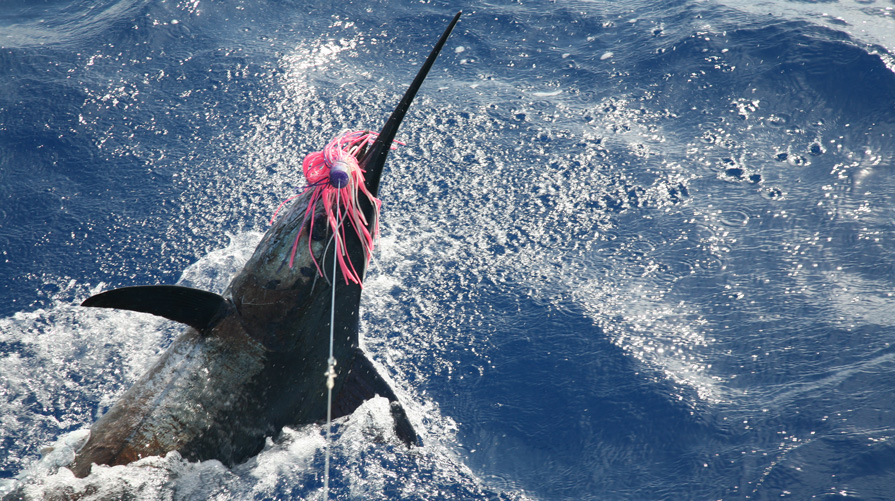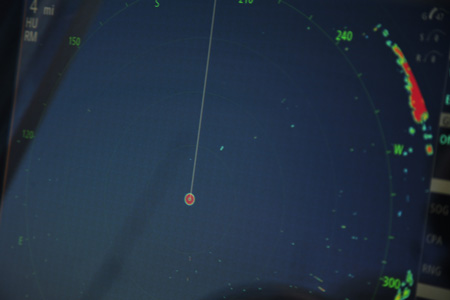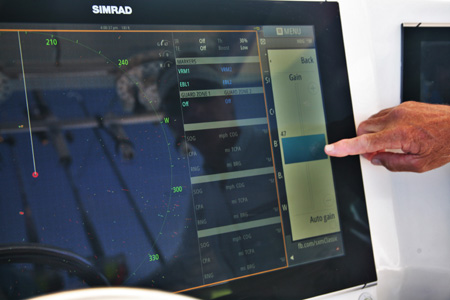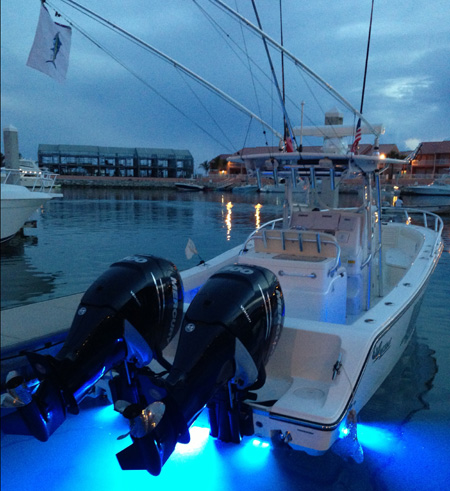
Successfully searching for marlin requires specific knowledge. This includes an understanding of historic migratory patterns for specific areas, and how water surface temperature breaks and ocean circulation features can dictate where and if billfish will appear along traditional fishing zones. The interaction of prominent underwater structures − canyons, sea mounts, tightly compressed fathom curves, etc.− with any current flow or an eddy is also important, since they form potent combinations that can ignite nutrient- and baitfish-rich upwellings, and major feeding blitzes.
Radar is another crucial component in locating billfish. A critical safety aid for navigating in the dark, fog and rain, radar has the advantage of locating birds at impressive distances – and working birds often unveil feeding-game fish − including marlin.

For example, with my radar, we continuously look for birds offshore. In one instance, after we dialed in a few, we picked up our trolling baits, and sped off from proven deep-water structure that had produced blue marlin for us in the past. Sure enough, six miles farther offshore − in wide open water and over flat bottom − those birds were over a school of dolphin. Some 30-minutes into the troll, we hooked a blue marlin!
The point is − the radar revealed birds, which led us to a school of dolphin far from proven bottom structure for marlin. Without that type of knowledge, we not only would have missed those open-water dolphin, but the blue marlin stalking them. Radar is undoubtedly a plus for uncovering feeding dolphin, blackfins, bonitos and even yellowfin tuna − when you track the birds following them. In those cases, your chances of hooking a blue marlin go up since there is excellent chance of blue marlin being near its food source. So, pay attention to birds, even if they’re not over heralded marlin spots.
Radar is often misunderstood, as a fishing aid. One misconception is that a closed dome antenna can spot birds as well as an open array antenna. To accurately read birds at distances well beyond the human eye – even with binoculars – it comes down to radar power and the size of the open array antenna. For example, a 6kW through 25kW open array antenna − ranging from four feet to ten feet, respectively, will provide enough power to broadcast and receive signals and mark birds over impressive distances. As a general rule, the narrower the antenna beam width, the farther the signal will broadcast and the greater target discrimination it will yield. A six-foot open array antenna will emit a narrower beam width and reach greater distances than a four-foot open array antenna. The markings from the six-foot antenna will also be much sharper and easier to discern.
On my 28 center console, I have the Simrad MO24-T, a 24-inch widescreen multi-touch unit, and a NSS9 evo2, a 9-inch touch screen unit. Both have radar with a four-foot open array, 6kW antenna. For birds, we set the radar’s outer limit at either four or six miles and fine tune the readings from there. My antenna is mounted on a T-top, not high on a bridge or tower. As a result, our distances are not as great as those from higher antenna mounts, but we’ll have plenty to get the job done - often in great fashion. We can read birds out to around eight miles, while larger sportfishing vessels with more powerful radar systems and higher antenna mounts can easily pick up birds up to 24 miles and beyond.


Another misconception among some who purchase a top-notch radar system is that their screens will simply scream birds when they’re offshore. Unless it’s a large gathering of birds, this is simply a fairy tale. It’s all about precision tuning and knowing exactly what to look for. As mentioned earlier, a four- or six-mile range is set on my radar. We’ll turn off the anti-sea surface and rain clutter controls, and advance the gain until the screen fills with noise. Next, the gain is slowly reduced until the screen noise just barely fades away. With a sensitive and clean screen, we watch for any“specs” to appear, which could indicate a single bird – such as a frigate, or a pair of birds. To the inexperienced, that “spec” might pass for noise, but we intensely study any “spec” on the screen, noting its position each time it fades and reappears during the antenna sweeps. By the third or fourth rotation of the antenna − and providing that “spec” remains in the same spot – we know it’s a bird(s) working over fish. We’ll then race off for it (note: activating the bearing to waypoint provides an easy line to follow). If the “spec” moves with each antenna sweep, we know it is a bird in motion, searching like we are. We don’t give chase in those cases.

The larger the gathering of birds, the more pronounced and intense the markings will be on the screen. These are easy to distinguish, but often, it’s the singles and pairs of birds − most notably frigates off South Florida, the Keys and throughout the Bahamas, which offer the best big-game potential.
To become proficient at dialing in a radar, choose a calm day and run several miles offshore. Start with closer ranges and learn how your unit interprets birds. Fine tune the radar to distinguish a single bird and its movements, paying close attention to the gain setting and the sharpest readings. From there, extend the range. You can also experiment with background colors, to determine which offers the best contrast for revealing subtle markings. In short time, you’ll become a master at picking off birds – and billfish.

